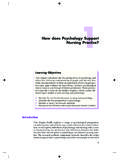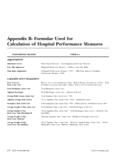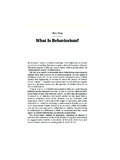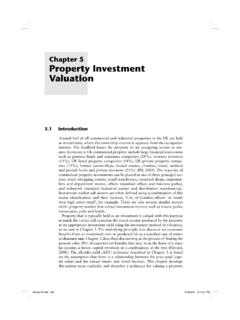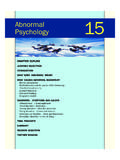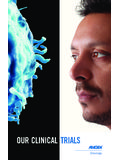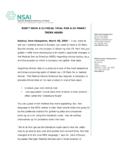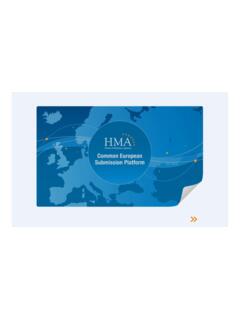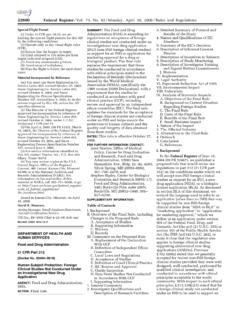Transcription of CHAPTER 3 Bias in randomized controlled trials
1 CHAPTER 3 bias in randomized controlled trialsThe main appeal of the randomized controlled trial (RCT) in health care comes from its potential to reduce selection bias . Randomiza-tion, if done properly, can keep study groups as similar as possible at the outset, so that the investigators can isolate and quantify the effect of the interventions they are studying. No other study design gives us the power to balance unknown prognostic factors at base-line. Random allocation does not, however, protect RCTs against other types of existence of most biases related to RCTs is supported mainly by common sense. In recent years, however, important research efforts have used RCTs as the subject rather than the tool of research. These studies are usually designed to generate empirical evidence to improve the design, reporting, dissemination, and use of RCTs in health They have confirmed that RCTs are vulner-able to many types of bias throughout their entire life span.
2 Random allocation of the participants to different study groups increases the potential of a study to be free of allocation bias , but has no effect on other important this CHAPTER we will discuss the concept of bias in relation to RCTs and highlight some of its sources. We will also list a variety of biases, as well as some strategies that may help us recognize them and minimize their impact on the planning of research and health-related is bias ?An online dictionary2 defines bias as a partiality that prevents objective consideration of an issue or situation . In statistics it means a tendency of an estimate to deviate in one direction from a true This systematic deviation from the true value can result in either underestimation 2930 CHAPTER 3or overestimation of the effects of an intervention. Because there is usually more interest in showing that a new intervention works than in showing that it does not work, biases in clinical trials most often lead to an exaggeration in the magnitude or importance of the effects of new should not jump to the conclusion that bias in health research is necessarily associated with a conscious or malicious attempt of investigators, funders, or readers to bend the results of a trial.
3 Indeed, although bias may be introduced into a trial intentionally, it is probably more commonly unintentional, and often unrecognized even by the researchers does bias in an RCT matter?The true effects of any health care intervention are unknown. We try to anticipate, detect, quantify, and control bias to produce results from a sample of participants that can be generalized to the target population at large. It is impossible to ever know for sure whether the results of a particular study are biased, simply because it is impossible to establish whether those results depart systemati-cally from a truth that remains are the main types of bias in RCTs?Most discussions on bias focus on biases that can occur during the actual course of a trial, from the allocation of participants to study groups, through the delivery of interventions, to the measurement of outcomes. Other types of bias can arise, however, even before the trial is carried out, in the choice of problem to study or type of research to use, or after the trial is carried out, in its analysis, and its dissemination.
4 bias can even be introduced by the person who is reading the report of a These biases, which can also have a profound influence on the way in which the results of RCTs are interpreted and used, tend to receive less illustrate how biases can affect the results of an RCT, we invite you to think about the following hypothetical scenario: Imagine a new drug for the treatment of multiple sclerosis, which has shown promising results in animal studies and in phase I trials . These results, which suggest that the drug can delay the onset of severe motor bias in RCTs 31compromise, have been widely publicized by the media during the past 3 months. Because of these results, patient advocacy groups are putting pressure on the government to make the new drug available as soon as possible. As multiple sclerosis is a debilitating disease that affects mil-lions of people worldwide and for which there is no known cure, the investigators (all clinicians who have dealt with multiple sclerosis patients for years), the company producing the new drug (which has invested millions in developing the drug), the media (interested in con-firming the results that they so widely publicized) and the potential par-ticipants (patients with multiple sclerosis who have been waiting for an effective treatment to be discovered) are all interested in demonstrating that the new compound is effective.
5 After many intense sessions debating the course of action, a multidisciplinary task force created by the gov-ernment, including consumer representatives, agrees that the next step should be a randomized clinical trial. A research protocol is produced by another multidisciplinary panel of investigators and consumers, and a well known research group at a large health care center is selected to conduct the study. We discuss the elements of this hypothetical scenario in the follo-wing biasWith true randomization, all participants in the study are given the same opportunity to be allocated or assigned to each of the study groups. But even a perfectly randomized method to allocate par-ticipants to the study groups does not protect against selection bias , which can occur both in the way that individuals are accepted or rejected for participation in a trial, and in the way that the inter-ventions are assigned to individuals once they have been accepted into a bias can occur if some potentially eligible individuals are selectively excluded from the study, because the investigator knows the group to which they would be allocated if they partici-pated.
6 Let us suppose that the investigator in charge of recruiting patients for the multiple sclerosis trial (who at least subconsciously hopes that the drug will be found to be effective) thinks that depressed patients are less likely to respond to the new drug. If he has access to the allocation sequence (which has been generated by computer and is locked in his desk) this investigator could intro-duce bias into the trial by making it more difficult for depressive 32 CHAPTER 3patients to receive the new drug. He could, knowingly or unknow-ingly, exclude depressive patients who would be allocated to receive the new drug by making them fit the exclusion criteria more easily than if they had been allocated to the placebo group. He could also (again knowingly or unknowingly) present information on the trial to depressive patients allocated to receive the new drug in such a way that they would be discouraged from consenting to participate.
7 At the end of the trial, if the investigator was right, and depressive patients were in truth less likely to respond to the new drug, the trial will show an exaggerated effect of the new drug during the treatment of multiple sclerosis, due to the disproportionate number of depressive patients in the placebo can selection bias be reduced?There is empirical evidence to show that effects of new interven-tions can be exaggerated if the randomization sequence is not con-cealed from the investigators at the time of obtaining consent from prospective trial One study showed that trials with inadequate allocation concealment can exaggerate the estimate of the effect size of interventions by as much as 40% on The irony is that allocation concealment is a very simple maneuver that can be incorporated in the design of any trial and that can always be its simplicity as a maneuver and its importance to reduce bias , allocation concealment is rarely reported, and perhaps rarely implemented in RCTs.
8 Allocation concealment was reported in less than 10% of articles describing RCTs published in prominent jour-nals in five different This does not necessarily mean that allocation is not concealed in 90% of RCTs; in some cases, allo-cation may have been concealed, but the authors, peer-reviewers, and journal editors were not aware of how important it is to men-tion it (it takes about a line in the report, so space limitation is not a good excuse). If, however, allocation concealment was not car-ried out in most cases in which it was not reported, the majority of RCTs are at risk of exaggerating the effects of the interventions they were designed to if the report of an RCT states that efforts were made to conceal the allocation sequence, there are many ways in which randomization can be subverted by investigators who want to break the allocation code before they obtain consent from prospec-tive trial Even when the allocation codes are kept bias in RCTs 33in sealed opaque envelopes, for instance, investigators can (and sometimes do) look through the envelopes using powerful lights or even open the envelope using steam and reseal it without others noticing.
9 Thus it is very easy to introduce selection bias into of RCTs should not get a false sense of security just because a study is biasAscertainment bias occurs when the results or conclusions of a trial are systematically distorted by knowledge of which intervention each participant is receiving. Ascertainment bias can be introduced by the person administering the interventions, the person receiv-ing the interventions (the participants), the investigator assessing or analyzing the outcomes, and even by the people who write the report describing the trial ( CHAPTER 2).The best way to protect a trial against ascertainment bias is by keeping the people involved in the trial unaware of the identity of the interventions for as long as possible. This is called blinding or masking. The strategies that can be used to reduce ascertainment bias can be applied during at least two periods of a trial: the time during which data are collected actively (from the administration of the interventions to the gathering of outcome data) and after data have been collected (from data analysis to the reporting of results).
10 It is important to recognize the difference between biases that are the result of lack of allocation concealment and biases that arise from lack of blinding. Allocation concealment helps to prevent selection bias , protects the randomization sequence before and until the interventions are given to study participants, and can always be implemented. Blinding helps prevent ascertainment bias , protects the randomization sequence after allocation, and cannot always be can ascertainment bias be reduced during data collection?Ascertainment bias can be introduced in different ways during data collection. For instance, the people administering the interven-tions can bias the results of a trial by altering systematically the co-interventions given to participants during the trial. Following our 34 CHAPTER 3example of the multiple sclerosis trial, the new drug may appear to be more effective at the end of the trial if patients allocated to the new drug received physiotherapy earlier and more intensively than patients allocated to placebo (co-intervention bias ).




